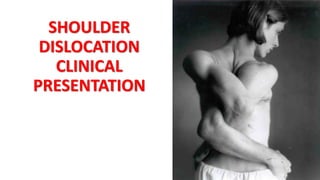
02. shoulder examination
- 2. History • Age • 2nd & 3rd decades instability • 4th & 5th decades impingement, frozen shoulder, inflammatory joint disease • 6th decade onwards rotator cuff tears , degenerative joint disease • Hand dominance • Occupation
- 3. Pain •ACJ pain usually well localised •Neck pain, pain over trapezius or medial border of scapula usually cervical in origin •Associated pain in wrist or hand +/- parasthesiae usually neurogenic •Poorly localised pain from deltoid region usually subacromial and rotator cuff pathology
- 4. Pain •Night pain often rotator cuff disease, glenohumeral arthritis and frozen shoulder •Sudden onset excruciating pain is typical of acute calcific tendonitis •Pain occurring in part of the range of shoulder abduction is termed painful arc
- 5. Instability • Any history of trauma? • Was shoulder dislocated? • How many dislocations since then? • Was dislocation spontaneous? If atraumatic dislocation is there history of joint laxity? • Painless clicks in the shoulder are common and usually have no significance
- 6. Weakness •Following traumatic event - important to exclude brachial plexus injury •May be due to pain (would examine with local anaesthetic joint examination in shoulder clinic)
- 7. Stiffness •Restriction of both passive and active movements •Usually associated with frozen shoulder, osteoarthritis, rheumatoid arthritis, chronic dislocation and cuff tear
- 8. Inspection (Look) •Undressed to the waist •Observe for difficulty getting undressed •Scars •Asymmetry or deformity of sternoclavicular joints •Outline and contour of clavicles and ACJ compared
- 9. Inspection (Look) • Squaring off of the shoulder profile from anterior dislocation, deltoid wasting or erosive arthritis with medialisation of humeral head • Bulk of pectoral and trapezius muscles should be compared • “Pop-Eye” appearance of biceps might signify rupture of long head of biceps • Winging of scapula caused by injury to long thoracic nerve
- 10. Palpation (Feel) •Start with sternoclavicular joint medially •Move along clavicle to ACJ •Tenderness over ACJ associated with degenerative change (common and not nec. abnormal) and traumatic subluxation
- 11. Palpation (Feel) • Palpation lateral and inferior to coracoid assoc with inflammatory arthropathy or primary frozen shoulder • Palpation should continue anterolaterally to intertubercular sulcus on humerus. Pain here may suggest biciptal tendonitis • Palpation of posterior joint line, where pain is more typical of osteoarthritis
- 12. Movement •Assess cervical spine to see if neck movements recreate shoulder symptoms •In full extension of C spine nose parallels the floor and in full flexion chin should rest on chest •Lateral rotation approx 80o •Lateral flexion 40o
- 13. Movement • Active and Passive range of movements of shoulder • Forward elevation (0-170) • Abduction (0-170) • External rotation with abduction (0-90) • Internal rotation (behind the back) • Comparison with contralateral side
- 14. Neurovascular assessment •Sensation dermatomes C4 toT2 •Power around elbow, wrist and hand •Shoulder power tested separately •Test peripheral nerves, esp. Axillary nerve •Biceps and triceps reflexes •Radial pulses
- 15. Special Tests • Deltoid • Arm in 90o abduction, neutral rotation • With resistance deltoid can be felt to contract • Supraspinatus • “empty cans test” • Subscapularis • “Push-off test” • Infraspinatus • “Swinging doors test”
- 16. Empty Cans Test Supraspinatus • The purpose of this test is to assist the integrity of the rotator cuff muscles. • It specifically targets the supraspinatus muscles. • Aids in the diagnosis of rotator cuff tears and shoulder impegment syndrome (SIS). 1. The patient is standing facing the examiner 2. In this test, the examiner resists abduction with the arm of the patient eleveted to 90˚ combined with internally rotation and 30˚ in the forward plane. 3. If the patient gives away, the test is considered positive.
- 17. Internal rotation lag sign test The purpose of this test is to assess tears of the subscapularis muscle. 1. The patient is asked to bring the arm behind the back with the palm facing outwards. 2. The arm is held in near maximum internal rotation and with the hand away from the back by approximately 20˚ of extension. 3. The patient is asked to hold the position while the examiner supports the elbow but releases the wrist hold. 4. If the patient is unable to hold the position, the lag sign is positive.
- 19. Other tests. Painful arc/Impingement test Internally rotated arm passively abducted in scapula plane (20-30 deg off coronal). Pain usually elicited in arc between 70-120o Scarf test ACJ injury Anterior apprehension test Arm externally rotated and shoulder abducted to 90 and elbow flexed. With gentle external pressure on back of humeral head, arm is externally rotated further
- 20. Scarf Test ACJ 1. The examiner forward flexes the involved arm of the patient to 90˚ (with elbow to 90˚) 2. A flexed arm is then passively adducted across the body putting an adduction stress on the acromioclavicular joint. 3. This position results in compression of the medial acromial facet against the distal clavicle to provoke symptoms at the acromioclavicular joint. 4. A positive test is indicated by reproduction of the patients symptoms.
- 21. Anterior Apprehension Test This test assists with the diagnosis of glenohumeral joint instability which can be caused by pathology to the labrum, rotator cuff muscles or joint capsule. This test evaluates specifically anterior joint instability. • As the shoulder is moved passively into maximum external rotation in abduction and forward pressure is applied to the posterior aspect of the humeral head, the patient complains of pain or instability.
